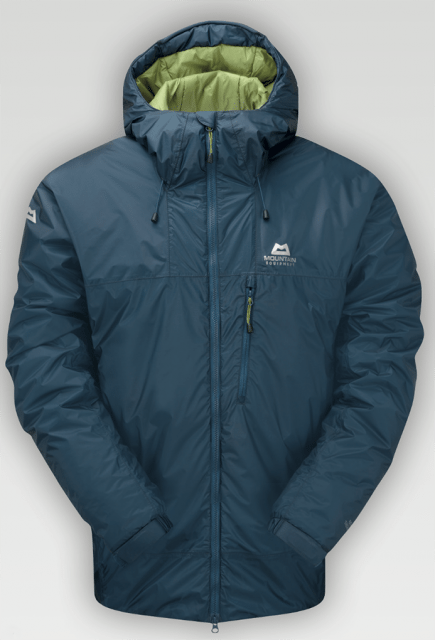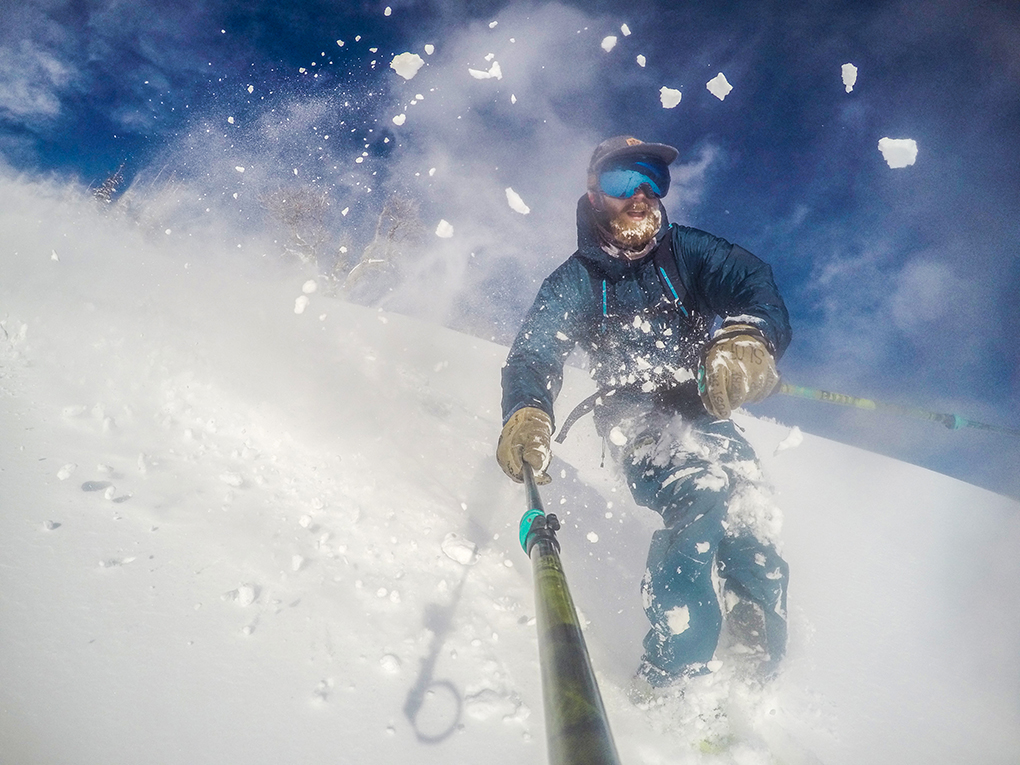
Mountain Equipment Prophet Jacket
Size Tested: L
Stated Weight: 510 g
Blister’s Measured Weight (L): 514 g
Front Zipper Length (size L): 74 cm
Stated Features:
- Fully seam sealed
- Mountain HC insulated hood with stiffened visor
- Alpine fit with pre-shaped and articulated sleeves
- 2-way YKK molded front zip with insulated baffle
- Adjustable cuffs and hem
Pockets:
- 2 Zippered hand warmer pockets
- 1 Napoleon chest pocket
- 1 Internal zippered mesh chest pocket
Construction:
- Shell: 10D Gore Thermium
- Insulation: PrimaLoft GOLD (80g throughout)
MSRP: $384 USD
Reviewer: 6’0”, 180 lbs
Test Locations: Jumbo Pass, BC; Teton Pass, Togwotee Pass, Grand Targhee, WY.
Days worn: 15
Back in November Gore announced they were rolling out a new material, Gore Thermium, to be used in insulating layers. The Mountain Equipment Prophet jacket is the first piece we’ve reviewed that uses Thermium, and we’ll dig deeper into what exactly Gore Thermium is later on in this review.
When I first saw Mountain Equipment’s Prophet Jacket at Outdoor Retailer, I thought to myself, “Cool, but I’ve got my layering system pretty dialed, so I don’t really see the need.” But my first day in the Prophet changed all that, and because of it, I’ve completely rethought my layering strategy for ski touring.
I’ve used the Prophet jacket while ski touring this winter in British Columbia and the Tetons, and I’ve found it to be such a versatile piece that I plan on using it extensively through the spring and summer, so I’ll be reporting back with a long-term durability update later.
What is Gore Thermium?
In rather typical fashion, Gore hasn’t released much information about the membrane Thermium uses, or what exact performance characteristics it’s supposed to have. However, after a fair bit of digging, we’ve come up with this overview.
Thermium is Gore’s newest laminate, and part of a rebrand / overhaul Gore is making which differentiates Gore-Tex, Gore Windstopper, and Gore Thermium. Here’s the breakdown:
“Gore Tex” encompasses: Gore-Tex Pro, Gore-Tex Active, and Gore-Tex C-Knit, all membranes that stick to the traditional Gore mantra: “Guaranteed to keep you dry.”
“Gore Windstopper” is now available in two flavors: (1) Light Rain Resistance and (2) Insulation Protection, and is meant to be windproof but breathable.
“Gore Thermium” is a two-layer, water- and wind-resistant, breathable membrane. It is water resistant to 15,000 mm, and Gore mandates that any garment using Thermium must be fully seam-sealed, which contributes to weatherproofing.
(For an in-depth breakdown of what that waterproofing rating means, check out Sam Shaheen’s excellent Outerwear 101 piece.)
Fit
Mountain Equipment says the Prophet has an “Alpine Fit,” and while that may conjure up images of a slim, very European fit, I actually found that the size Large was cut more generously than any of the insulators I’ve worn recently, including the size Large Patagonia Nano Air, Patagonia Down Sweater, and the Large Trew Kooshin.

That said, I’m not swimming in the Prophet. It still fits well under most of my shells (although it’s definitely a bigger fit than the Trew Wander Jacket), but is big enough that it also fits easily over most of them, something that hugely contributes to its versatility.
Hood
The Prophet’s hood is the best I’ve used on an insulating layer. It easily fits over a climbing helmet, and can fit over a ski helmet as well (although it is a little snug). The wire brim does a good job of keeping the hood out of your field of vision, and it adjusts easily, and stays secure if you’re not wearing a helmet.
I’m used to the hoods on packable pieces like this being very minimalistic, and thus, not that useful, but Mountain Equipment has done a great job with the Prophet.
Zippers
The Prophet uses a molded YKK 2-way zipper on the front that is easy to adjust even with heavy gloves on, and is handy if you happen to be using this jacket over a harness.
The pockets use lighter coil zippers, and they have also been easy to use so far as well.
Pockets
The Prophet’s hand pockets are big enough to stow a pair of gloves or goggles, and the right pocket doubles as the jacket’s stuff sack.
The Napoleon pocket fits a phone or wallet and a pair of sunglasses, while the inner mesh pocket fits goggles or snacks easily.
Stuff Sack
The right hand pocket of the Prophet has a double-sided zipper, and it doubles as the stuff sack. This stuff sack compresses the jacket much tighter than any sack I’ve used before, something that I came to appreciate. While this means that it takes a little longer to stuff the jacket, it also packs down smaller than I’d expect from a synthetic insulator. In fact, in its stuff sack, the Prophet is a little smaller than the Patagonia Hooded Down sweater I’d been using before.
All in all, the Prophet is impressively packable, especially given its well-thought-out features and useful hood.
On the Mountain, Breathability, Etc.

Synthetic insulations, especially high clo long-staple insulations like Primaloft Gold, will degrade with repeated stuffings, especially if packed tightly. The structure of the fine long fibers is lost, unlike with down. If I remember correctly, Primaloft Gold has a clo/oz around .90, and will degrade to around .60 under heavy stuffing (losing 30% of its warmth). I much prefer to loosely stuff my synthetic insulators for this reason. Just something to think about when using the pocket-as-a-stuffsack.
Glad to hear you’re enjoying the baselayer – shell – external puffy layering system. I started doing this a few years ago and will never go back to a midlayer system again for the reasons you state. Personally, I prefer a softshell over a hardshell for the drier intermountain areas, as I find them to be more versatile. I can select the perfect baselayer for the temps, and then put on the softshell when I break treeline to cut the wind but still provide great breathability for high output touring. With a hardshell, I find them to be nowhere near breathable enough to do this unless its really nasty out or I pick a baselayer thats just not warm enough to wear below treeline without a shell. Very much a goldilocks situation. A windshirt can work as a substitute for a softshell too, but I find that they don’t breathe as well (but still better than a hardshell). Food for thought.
The inverse layering system described here and above in Brian’s comment is blowing my mind… does that really work for you guys? It seems a lot less comfortable and flexible to have a stiff/plasticy shell closer to the skin than a light, puffy jacket.
I have the Nano Air and it’s completely changed how I dress (caveat: I almost exclusively ski the Rockies so wetter climates could completely wreck my system). I use a rotation of generic brand marino wool baselayers, a sweater/hoody if it’s bitterly cold, my Nano Air, and then a shell. I rarely use my shell unless I’m skiing bitterly exposed faces with high winds, or dealing with single digit (and lower) temps as I also run pretty hot (hot enough to wish the Nano Air had armpit zips on some days). Plus I’ve found the Nano Air plenty water resistant, even on the deepest of powder days, if you simply do a quick shake to get excess snow off at the end of a run. This could entirely be a luxury afforded by the arid climates I ski, but over the past year and a half I’ve met plenty of people who travel much farther than I and have heard the Nano Air holds up similarly from Washington to the Alps. This all means my Nano Air is rarely stuffed (Brian makes a great point about this), but conversely when the conditions are right I’m pulling my shell off and on an annoying amount of times.
Is the prophet good enough to justify cheating on my current system? I can deal with almost any condition with three pieces right now, and they all can fit within a camelbak, but if the prophet can combine both the Nano Air and the shell in one piece while staying breathable enough for high energy powder days and more importantly sunny, warm spring days I’m more than game.
Yeah, I agree with Brian. I can’t tour in a Nano Air, it’s too warm for me. On the coldest days I’m in a merino t-shirt base layer with a Corbeaux Recon Hoody, and maybe my shell. (And Brian makes a good point on hard vs. soft shells)
When I was using the Nano Air or Trew Kooshin I was usually only putting them on at the top, and having to take my shell off to do so. So the Prophet fills exactly that role, but as I state in the review, gets me more weatherproofing and warmth and fits better over a shell.
For example, yesterday I ran out on a tour, we started below treeline, and things have been warm around here, so I was just in softshell pants and a t-shirt. About 2/3 of the way up we popped out of the trees and onto a ridge. Here things got breezy, so I threw on a softshell, and ran up to the top. At the top the wind was really cranking, so I threw the Prophet over my softshell while I waited for the group. They got up top, and I left the Prophet on for the ski down, since it was cold enough I didn’t want to just go with a shell. When we got back into the woods the Prophet went back into my pack for the rest of the ski out. That meant that I never had to take off my shell to control my level of insulation.
If I’d been using a Nano Air or similar I would have had to take my shell off at the top to put it on, and at the bottom to take it off.
All that said, for non-human powered skiing, the Nano Air or Kooshin are both great. When I’m skiing inbounds on colder days I’ll go baselayer, Kooshin, shell every time.
Brian also makes a good point on the synthetic insulation front. For trips where space and organization is a priority, and I’m bringing more gear, I’ll use the stuff sack. For everything else I just loosely stuff it into my pack.
Its not as inverse as you’d think. Its a really common layering strategy for mountaineering (the belay puffy system). A softshell is far from plasticky and stiff by the way. Its way more similar to the nano air, but without the insulation.
FWIW, the Nano Air is WAY too warm for touring, for me. Even when its negative F, I don’t need a fleece heavier than a 100, and when paired with a softshell I’m comfortable above treeline on the coldest of days unless its really nasty out, and then I want full wind protection from a superlight puffy on top.
Which trousers from mountain equipment are you wearing in your picture?
Do you think this would work well as a belay jacket for cold but not truly nasty conditions? Say, freezing to a little below freezing?